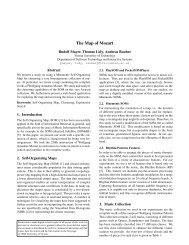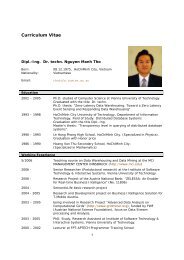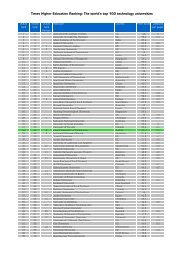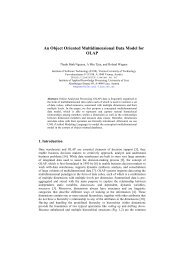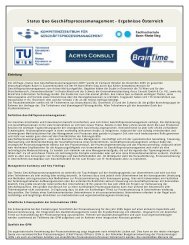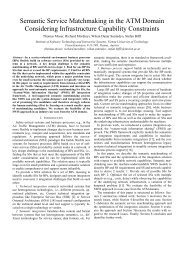Using Psycho-Acoustic Models and Self-Organizing Maps to Create ...
Using Psycho-Acoustic Models and Self-Organizing Maps to Create ...
Using Psycho-Acoustic Models and Self-Organizing Maps to Create ...
Create successful ePaper yourself
Turn your PDF publications into a flip-book with our unique Google optimized e-Paper software.
˜<br />
‘<br />
Œ<br />
Œ<br />
‘<br />
¥<br />
<strong>Using</strong> <strong>Psycho</strong>-<strong>Acoustic</strong> <strong>Models</strong> <strong>and</strong> ¢¡¤£¦¥ <strong>to</strong> create a Hierarchical Structuring of Music<br />
<strong>and</strong> the loudness of the 1kHz <strong>to</strong>ne at 40dB is defined <strong>to</strong> be ªZ`'g._ .<br />
A sound perceived <strong>to</strong> be twice as loud is defined <strong>to</strong> be 2 `=g=_ <strong>and</strong><br />
so on. In the first stage of the feature extraction process, this specific<br />
loudness sensation (Sone) per critical-b<strong>and</strong> (Bark) in short time<br />
intervals is calculated in 6 steps starting with the PCM data.<br />
) First the power spectrum of the audio signal is calculated. To<br />
(Ž€<br />
do this, the raw audio data is first decomposed in<strong>to</strong> its frequencies<br />
using X4~NX5 [Q\ *_ \u«s\ gsSr \¬ ~g®X X «'¯<br />
a . We use a window<br />
size of 256 samples, which corresponds <strong>to</strong> about 23ms at 11kHz,<br />
<strong>and</strong> a Hanning window with 50% overlap. We thus obtain a Fourier<br />
transform of 11 / 2 kHz, i.e. 5.5 kHz signals.<br />
) The inner ear separates the frequencies <strong>and</strong> concentrates them<br />
(ŽF„<br />
at certain locations along the basilar membrane. The inner ear<br />
can thus be regarded as a complex system of a series of b<strong>and</strong>pass<br />
filters with an asymmetrical shape of frequency response. The<br />
center frequencies of these b<strong>and</strong>-pass filters are closely related <strong>to</strong> the<br />
critical-b<strong>and</strong> rates, where frequencies are bundled in<strong>to</strong> 24 criticalb<strong>and</strong>s<br />
according <strong>to</strong> the d| \ scale [37]. Where these b<strong>and</strong>s should<br />
be centered, or how wide they should be, has been analyzed through<br />
several psychoacoustic experiments. Since our signal is limited <strong>to</strong><br />
5.5 kHz we use only the first 20 critical b<strong>and</strong>s, summing up the<br />
values of the power spectrum within the upper <strong>and</strong> lower frequency<br />
limits of each b<strong>and</strong>, obtaining a power spectrum of the 20 critical<br />
b<strong>and</strong>s for the segments.<br />
) Spectral Masking is the occlusion of a quiet sound by a louder<br />
(ŽF¦<br />
sound when both sounds are present simultaneously <strong>and</strong> have similar<br />
frequencies. Spectral masking effects are calculated based on [31],<br />
with a spreading function defining the influence of ° the -th critical<br />
b<strong>and</strong> on the -th being used <strong>to</strong> obtain a spreading matrix. <strong>Using</strong><br />
this matrix the power spectrum is spread across the critical b<strong>and</strong>s<br />
obtained in the previous step, where the masking influence of a<br />
critical b<strong>and</strong> is higher on b<strong>and</strong>s above it than on those below it.<br />
) The intensity unit of physical audio signals is sound pressure<br />
(Ž4±<br />
<strong>and</strong> is measured ‚:© in (Pa). The values of the PCM data<br />
correspond <strong>to</strong> the sound pressure. Before `=g._ calculating values<br />
it is necessary <strong>to</strong> transform the data in<strong>to</strong> decibel. The decibel value<br />
of a sound is calculated as the ratio between its pressure <strong>and</strong> the<br />
pressure of the hearing threshold, also known as dB-SPL, where<br />
SPL is the abbreviation for sound pressure level.<br />
) The relationship between the sound pressure level in decibel<br />
(ŽF²<br />
<strong>and</strong> our hearing sensation measured `'g._ in is not linear. The<br />
perceived loudness depends on the frequency of the <strong>to</strong>ne. From the<br />
dB-SPL values we thus calculate the equal loudness levels with their<br />
unit Phon. The ‚Nhsg levels are defined through the loudness in dB-<br />
SPL of a <strong>to</strong>ne with 1kHz frequency. A level of 40 ‚0hsg resembles<br />
the loudness level of a 40dB-SPL <strong>to</strong>ne at 1kHz. A pure <strong>to</strong>ne at<br />
any frequency with 40 ‚0hsg is perceived as loud as a pure <strong>to</strong>ne<br />
with 40dB at 1kHz. We are most sensitive <strong>to</strong> frequencies around<br />
2kHz <strong>to</strong> 5kHz. The hearing threshold rapidly rises around the lower<br />
<strong>and</strong> upper frequency limits, which are respectively about 20Hz <strong>and</strong><br />
16kHz. Although the values for the equal loudness con<strong>to</strong>ur matrix<br />
are obtained from experiments with pure <strong>to</strong>nes, they may be applied<br />
<strong>to</strong> calculate the specific loudness of the critical b<strong>and</strong> rate spectrum,<br />
resulting in loudness level representations for the frequency ranges.<br />
) Finally, as the perceived loudness sensation differs for different<br />
(ŽF³<br />
loudness levels, the specific loudness sensation `=g=_ in is calculated<br />
based on [3]. The loudness of the 1kHz <strong>to</strong>ne at 40dB-SPL is defined<br />
<strong>to</strong> be 1 Sone. A <strong>to</strong>ne perceived twice as loud is defined <strong>to</strong> be `=g=_ 2<br />
<strong>and</strong> so on. For values up <strong>to</strong> ‚0hsg 40 the sensation rises slowly,<br />
increasing at a faster rate afterwards.<br />
Figure 2 illustrates the data after each of the feature extraction steps<br />
using the first 6-second sequences extracted from d{__:~yhs´_:g¢µNXZY [Q\<br />
] © A$_ <strong>and</strong> from ^ \ g¢µ·X \ _fģ º¹F_C»h . The sequence of XZY<br />
Amplitude<br />
0.05<br />
0<br />
−0.05<br />
Frequency [kHz]<br />
Critical−b<strong>and</strong> [bark]<br />
Critical−b<strong>and</strong> [bark]<br />
Critical−b<strong>and</strong> [bark]<br />
Critical−b<strong>and</strong> [bark]<br />
4<br />
2<br />
PCM Audio Signal<br />
Power Spectrum [dB]<br />
0<br />
Critical−B<strong>and</strong> Rate Spectrum [dB]<br />
20<br />
15<br />
10<br />
5<br />
Spread Critical−B<strong>and</strong> Rate Spectrum [dB]<br />
20<br />
15<br />
10<br />
5<br />
20<br />
15<br />
10<br />
5<br />
Specific Loudness Level [phon]<br />
Specific Loudness Sensation [sone]<br />
20<br />
15<br />
10<br />
5<br />
†ˆ‡y‰=ŠF‹Œ<br />
¡ ‡S‰.š<br />
Beethoven, Für Elise<br />
0 2 4<br />
Time [s]<br />
60<br />
40<br />
20<br />
60<br />
40<br />
20<br />
60<br />
40<br />
20<br />
60<br />
40<br />
20<br />
5<br />
4<br />
3<br />
2<br />
1<br />
Amplitude<br />
Frequency [kHz]<br />
Critical−b<strong>and</strong> [bark]<br />
Critical−b<strong>and</strong> [bark]<br />
Critical−b<strong>and</strong> [bark]<br />
Critical−b<strong>and</strong> [bark]<br />
1<br />
0<br />
−1<br />
4<br />
2<br />
PCM Audio Signal<br />
Power Spectrum [dB]<br />
0<br />
Critical−B<strong>and</strong> Rate Spectrum [dB]<br />
20<br />
15<br />
10<br />
5<br />
Spread Critical−B<strong>and</strong> Rate Spectrum [dB]<br />
20<br />
15<br />
10<br />
5<br />
20<br />
15<br />
10<br />
5<br />
Specific Loudness Level [phon]<br />
Specific Loudness Sensation [sone]<br />
20<br />
15<br />
10<br />
5<br />
Korn, Freak on a Leash<br />
0 2 4<br />
Time [s]<br />
—OuŽ€Rœ:Ž5³4 ž ‹˜.’ ‘9¼ €'€Q½4¾ ¢¿^ÀÁ ŠF£F‡y˜<br />
„4ZŽ4‘ Œs‡S¦¡y˜.Š5£ š5Œ<br />
z—<br />
Œs‹ZR‹9‡ ‡A ¡<br />
œÃF š5£<br />
—<br />
© A$_ contains the main theme starting shortly before the 2nd second.<br />
]<br />
The specific loudness sensation depicts each piano key played. On<br />
the other X \ _¤gÄj¹F_C»h h<strong>and</strong>, , which is classified p¢_C´} as<br />
, is quite aggressive. Melodic elements do not<br />
bv_:~*©Å"Æ^_C~yhubc_:~*©<br />
play a major role <strong>and</strong> the specific loudness sensation is a rather<br />
complex pattern spread over the whole frequency range, whereas<br />
only the lower critical b<strong>and</strong>s are active XZY [Q\] © A$_ in . Notice further,<br />
that the values of the patterns X \ _C9vģ q¹F_C»h of are up <strong>to</strong> 18<br />
times higher compared <strong>to</strong> those XZY [Q\{] © A$_ of .<br />
3.3 Rhythm Patterns<br />
After the first preprocessing stage a piece of music is represented<br />
by several 6-second sequences. Each of these sequences contains<br />
information on how loud the piece is at a specific point in time in a<br />
specific frequency b<strong>and</strong>. Yet, the current data representation is not<br />
time-invariant. It may thus not be used <strong>to</strong> compare two pieces of<br />
music point-wise, as already a small time-shift of a few milliseconds<br />
will usually result in completely different feature vec<strong>to</strong>rs. In the<br />
second stage of the feature extraction process, we calculate a timeinvariant<br />
representation for each piece of music in 3 further steps,<br />
namely the frequency-wise rhythm pattern. These rhythm patterns<br />
contain information on how strong <strong>and</strong> fast beats are played within<br />
the respective frequency b<strong>and</strong>s.<br />
) The loudness of a critical-b<strong>and</strong> usually rises <strong>and</strong> falls several<br />
(Çj€<br />
times resulting in a more or less periodical pattern, also known as<br />
the rhythm. The loudness values of a critical-b<strong>and</strong> over a certain<br />
time period can be regarded as a signal that has been sampled at<br />
discrete points in time. The periodical patterns of this signal can<br />
then be assumed <strong>to</strong> originate from a mixture of sinuids. These<br />
sinuids modulate the amplitude of the loudness, <strong>and</strong> can be calculated<br />
by a Fourier transform. The modulation frequencies, which<br />
80<br />
60<br />
40<br />
20<br />
80<br />
60<br />
40<br />
80<br />
60<br />
40<br />
80<br />
60<br />
40<br />
25<br />
20<br />
15<br />
10<br />
5<br />
[Q\





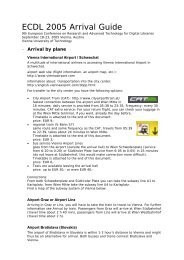
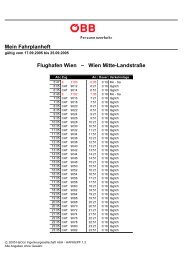
![Informationsvisualisierung [WS0708 | 01 ]](https://img.yumpu.com/22537403/1/190x143/informationsvisualisierung-ws0708-01-.jpg?quality=85)
